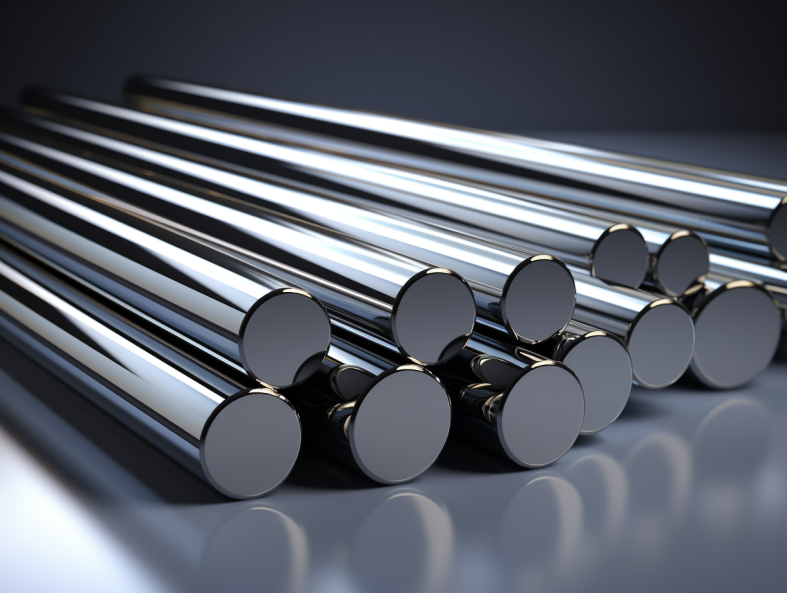概要
超硬合金 タングステンカーバイトロッドとして知られるロッドは、その比類のない硬度、耐摩耗性、耐久性により、現代の産業用アプリケーションの礎石として登場しました。タングステンカーバイド棒は、機械加工、穴あけ、その他精密さが要求される作業を一変させました。この総合ガイドでは、超硬ロッドの特性、動作原理、用途、加工方法、分類、市場動向について詳しく説明します。業界のベテラン、初心者を問わず、超硬ロッドの優れた能力に関する貴重な洞察を得ることができます。
詳細紹介
超硬ロッドとは?
超硬ロッドは、炭化タングステン粒子を金属バインダー(通常はコバルト)で結合した複合材料から作られる円柱状の工具です。この組み合わせにより、驚異的な硬度と耐摩耗性を持つ材料が得られ、さまざまな産業用途に最適です。

動作原理
超硬ロッドの有効性は、そのユニークな材料特性にある:
- 硬度:タングステンカーバイドは、最も硬い材料の1つであり、卓越した切削・加工能力を提供します。
- 耐摩耗性:高い耐摩耗性により、ロッドは過酷な条件にも耐え、長期間にわたって完全性を維持できる。
- 熱安定性:高温下でも硬度を保つため、高速加工や過酷な用途に適しています。
- 耐食性:耐腐食性により、過酷な環境下でもロッドの寿命が延びる。
超硬ロッドの使い方
超硬ロッドは汎用性が高く、以下のような数多くの用途に使用されている:
- 切削工具:精密な材料除去のためのエンドミル、ドリルビット、リーマーに使用。
- 鉱山・建設機械:削岩機や建設用ブレードに使用。
- ウェアパーツ:バルブシート、ノズル、その他の部品として機械に使用される。
- 精密部品:測定工具、パンチ、ダイに使用される。
- 医療機器:その精度と信頼性から、手術器具や歯科器具に使用されている。
加工方法
超硬ロッドの加工には、いくつかの重要な段階がある:
- 粉体混合:炭化タングステン粉末をバインダー金属(通常はコバルト)と結合させること。
- プレス:プレス機で棒状に成形する。
- 焼結:プレスされたロッドを高温で加熱し、粒子同士を結合させる。
- 研磨:所望の寸法と表面仕上げを達成するための精密研削。
- コーティング:性能と寿命を向上させる高度なコーティングを施す。
分類と品種
超硬棒は、その組成、粒度、用途によって分類されます。一般的な分類は以下の通り:
- マイクロ・グレイン:高い精度と切れ味が要求される用途向け。
- ミディアム・グレイン:靭性と耐摩耗性のバランスが良く、一般的な使用に適している。
- 粗目:高い靭性と耐衝撃性が要求される用途向け。
市場ダイナミクス
超硬合金棒の市場は、製造業、鉱業、医療産業における需要の増加に牽引され、堅調に拡大している。主なトレンドは以下の通り:
- 技術の進歩:コーティング技術と材料配合の革新。
- 持続可能性:リサイクルや環境に優しい生産工程を重視する傾向が強まっている。
- グローバリゼーション:新興経済国における市場の拡大、競争と技術革新の激化。
製品情報
次の表は、超硬合金棒の種類、組成、特性、特徴、仕様、サイズ、等級、規格などの詳細情報である。
| タイプ | 構成 | プロパティ | 特徴 | 仕様 | サイズ | グレード | 規格 |
|---|---|---|---|---|---|---|---|
| マイクロ・グレイン | WC + Co (5-8%) | 高い硬度 | 優れた精度 | 直径1~20mm | カスタマイズ可能な長さ | 極細 | ISO 9001 |
| ミディアム・グレイン | WC + Co (6-10%) | バランスの取れたタフネス | 多彩なアプリケーション | 直径1~25mm | カスタマイズ可能な長さ | スタンダード | ISO 9001 |
| 粗目 | WC + Co (10-15%) | 高い耐衝撃性 | タフネスと耐久性 | 直径1~30mm | カスタマイズ可能な長さ | ヘビーデューティー | ISO 9001 |
| ナノコーティング | WC + Co + ナノコーティング | 優れたパフォーマンス | 耐摩耗性の向上 | 直径1~20mm | カスタマイズ可能な長さ | 上級 | ISO 9001 |
テーブル内容の説明
この表は、超硬ロッドの種類とそれぞれの特性を示しています。各タイプは、特定の用途に合わせて調整されており、硬度、靭性、耐摩耗性の面で独自の利点を提供します。仕様と規格により、ユーザーは正確なニーズに適したロッドを見つけることができます。
アプリケーション
超硬ロッドは、さまざまな産業で不可欠です。主な用途をいくつかご紹介します:
- 機械加工と金属加工:エンドミル、ドリルビット、リーマーなどの切削工具に使用される。
- 鉱業:効率的で耐久性のある性能のため、削岩工具に採用。
- 建設:強靭な材料を切断するために、建築用ブレードや鋸に組み込まれている。
- 自動車:エンジン部品などの精密部品に使用。
- 航空宇宙:極めて高い耐久性が要求される高精度工具や部品に使用される。
- メディカル:その精度と信頼性から、手術器具や歯科器具に組み込まれている。
- 石油・ガス:過酷な条件にも耐えるため、掘削装置や摩耗部品に使用される。
- エレクトロニクス:電子部品の精密製造に従事。
比較
次の表は、TRUERと超硬ロッドのさまざまなサプライヤーを、サプライヤ、所在地、価格帯、1個あたりのコスト、および特殊性に焦点を当てて比較したものです。
| サプライヤー | 所在地 | 価格帯 | 1個あたり | 特産品 |
|---|---|---|---|---|
| TRUER | グローバル | $10 – $50 | $30 | 高精度、高度なコーティング |
| ケナメタル | アメリカ | $15 – $60 | $40 | 豊富な製品群、最先端技術 |
| サンドビック | スウェーデン | $20 – $70 | $45 | 高い耐久性と革新的なソリューション |
| 三菱 | 日本 | $12 – $55 | $35 | 高性能、高品質の一貫性 |
テーブル内容の説明
この表は、TRUERと他の超硬棒サプライヤーの比較分析です。立地、価格帯、得意分野などの重要な側面を強調し、市場で利用可能な選択肢を明確に示しています。
長所と短所
以下の表は、超硬ロッドの長所と短所をまとめたもので、その利点と限界についてバランスの取れた見解を示している。
| 長所 | 短所 |
|---|---|
| 卓越した硬度と耐摩耗性 | いくつかの代替品に比べ、イニシャルコストが高い |
| 長寿命で交換頻度を低減 | 加工に特殊な装置が必要 |
| 高い熱安定性 | 特定の条件下では脆くなることがある |
| 業種を問わない多彩なアプリケーション | 特定の高精度用途に限定 |
| リサイクル・オプションで環境に優しい | 先進コーティングの初期設定コスト |
テーブル内容の説明
この表は、超硬ロッドの利点と欠点を概説し、その利点と限界についてバランスの取れた見方を提供するものである。この表は、超硬ロッドを用途に選ぶ際のトレードオフを理解するのに役立ちます。
追加情報
先進コーティング技術
ダイヤモンドやナノコーティングなどの高度なコーティングの開発により、超硬ロッドの性能は大幅に向上した。これらのコーティングは、さらなる硬度と耐摩耗性を提供し、ロッドの耐久性と効率をさらに向上させる。
持続可能な製造慣行
環境の持続可能性に対する意識の高まりに伴い、超硬ロッドの生産は環境に優しいやり方へとシフトしている。環境への影響を軽減するために、リサイクル・プログラムやより環境に優しい製造工程が実施されている。
スマート・テクノロジーとの統合
IoT対応ツールやAIを活用したメンテナンスシステムなどのスマートテクノロジーの統合は、超硬ロッドの使用に革命をもたらしている。これらの技術により、リアルタイムのモニタリングと予知保全が可能になり、性能が最適化され、ダウンタイムが削減される。
TRUERを選ぶ理由
超硬ロッドのニーズにTRUERをお選びいただくことで、高品質で精密に設計された製品をご利用いただけます。TRUERは高度なコーティング、幅広いサイズと仕様、そして持続可能性へのコミットメントを提供します。グローバルな展開と競争力のある価格設定により、世界中の産業界の信頼できるパートナーとなっています。
よくあるご質問
Q1: 超硬ロッドが他の切削工具材料より優れている理由は何ですか?
A1: 超硬ロッドは、その卓越した硬度、耐摩耗性、熱安定性により優れています。これらの特性により、精密で効率的な切削が可能になり、工具の交換やメンテナンスの頻度を減らすことができます。
Q2: 超硬ロッドの粒径は性能にどのように影響しますか?
A2: 粒度は硬度と靭性のバランスに影響する。微粒棒は高い精度と切れ味を提供し、中粒棒は靭性と耐摩耗性のバランスを提供し、粗粒棒は高衝撃用途に最適です。
Q3: 超硬合金棒に環境に優しい選択肢はありますか?
A3: TRUERを含む多くのメーカーは、超硬棒の生産による環境への影響を軽減するため、持続可能な慣行やリサイクルプログラムを採用しています。環境に優しい選択肢はますます増えています。
Q4: 超硬ロッドの使用で最も恩恵を受ける産業は何ですか?
A4: 機械加工、金属加工、鉱業、建設、自動車、航空宇宙、医療、石油・ガス、エレクトロニクスなどの業界では、その耐久性と精度の高さから、超硬ロッドを使用するメリットが最も大きい。
Q5: 超硬ロッドの性能をどのように高めるのですか?
A5: ダイヤモンドやナノコーティングなどの高度なコーティングは、硬度、耐摩耗性、熱安定性を向上させ、超硬ロッドの性能を高めます。これらのコーティングは、ロッドの寿命を延ばし、要求の厳しい用途での効率を向上させます。




